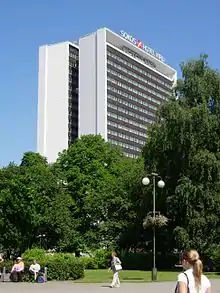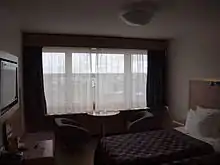Sokos Hotel Viru
The Original Sokos Hotel Viru Tallinn is a hotel in Tallinn, Estonia. Originally owned by Intourist and called Viru hotell, it was first opened on 5 May 1972. The hotel building was the first high-rise building in Estonia and an inseparable part of the Tallinn cityscape. Nowadays the hotel is connected to the shopping centre Viru Keskus. Nowadays, the hotel belongs to Sokos Hotels.


The Soviet Union gave the construction project of Viru hotel to the construction company Repo Oy from Savonlinna, Finland in 1969, and construction of the hotel started in July 1969. However, the construction company went bankrupt in the middle of the construction project in 1971, after a fire had broken out on the top floors of the hotel in December 1970. Because of prestige reasons, the Finnish state had to find another construction company, and provide a state backing for the project. The new construction company Haka Oy finished the hotel in May 1972. The project paid well off, because it resulted in a new construction project in Pääjärvi in the same year, and later new construction projects in Enso and Kostamus (all these being in the Republic of Karelia).[1]
During the Soviet era, the 23rd floor of the hotel housed a KGB radio centre, used to eavesdrop and spy on the hotel guests. 60 of the hotel rooms had concealed espionage devices, and even some of the tables in the restaurant had microphones. The KGB left the hotel in a hurry right before the independence of Estonia in August 1991, but the secret rooms were not found until 1994. The former radio centre is now a museum.[2]
In 2003, the hotel was sold to the S Group, a Finnish retailing cooperative organisation. It now has 516 rooms.[3]
Further reading
- Nupponen, Sakari: Aikamatka hotelli Viruun. Ajatuskirjat, 2007. ISBN 978-951-20-7472-3.